








Dear Readers,
Thank you for joining us for our fall 2022 issue. We are very pleased to be back in time for NBAA-BACE Orlando. Business aviation is a thriving industry of which we are proud to be a part.
So much has happened since the last quarter. We learned a great deal about Top Gun: Maverick, the movie, from aerial coordinator and motion picture pilot, Kevin ‘K2’ LaRosa II. As well, we learned valuable lessons from our writers in the industry, including John Goglia, Mark DiLullo, and Matt Odenbrett.
We know that business jets and jobs in the business aviation industry are in high demand, and we are proud to support this industry with all the latest news and interesting byline stories.
I would like to thank our advertisers for their contributions as well as our staff, including Partner Eli Stepp, Associate Publisher Paul T. Glessner, Graphic Artist Matt DuBois, and Editor Vickie Buonocore.
We look forward to presenting you with more great articles in the business aviation industry this winter. Enjoy Orlando!
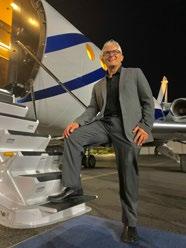
Sincerely,
Annamarie Buonocore & Eli Stepp Co-Publishers BizAvJets USA Magazine

Managing Editor
Editor
Associate Publisher/Editor
Sales
P.O. Box 5402, San Mateo, CA 94402 (650) 358-9908, Fax (650) 358-9254
Annamarie Buonocore and Eli Stepp (702/465-2027)

Vickie Buonocore
Matt DuBois
Paul T. Glessner John Goglia, Mark DiLullo and Matt Odenbrett
Paul T. Glessner (paul@bizavjetsusa.com) and
Business matters, advertising and editorial concerns should be addressed to In Flight USA, P.O. Box 5402, San Mateo, Calif. 94402 or by calling (650) 358-9908–fax (650) 358-9254. Copyright © 2008-2021 In Flight Publishing.
BizAvJets USA is not responsible for any action taken by any person as a result of reading any part of any issue. The pieces are written for information, entertainment and suggestion – not recommendation. The pursuit of flight or any action reflected by this paper is the responsibility of the individual and not of this paper, its staff or contributors. Opinions expressed are those of the individual author, and not necessarily those of BizAvJets USA
All editorial and advertising matter in this edition is copyrighted. Reproduction in any way is strictly prohibited without writ ten permission of the publisher.
BizAvJets USA is not liable or in any way responsible for the condition or airworthiness of any aircraft advertised for sale in any edition. By law the airworthiness of any aircraft sold is the responsibility of the seller and buyer.
 By Elijah Stepp
By Elijah Stepp
Kevin ‘K2’ LaRosa II standing in front of an L-39 jet. (Photo courtesy of Kevin LaRosa II)
BizAvJets USA Magazine journalists are extremely fortunate to often meet with top professionals in the BizAv industry. Imagine our excitement to meet with Top Gun: Maverick aerial coordinator and motion picture pilot, Kevin ‘K2’ LaRosa II! He was in the pilot’s seat of the camera aircraft capturing most of the filming of Top Gun: Maver ick. Kevin was also tasked by Tom Cruise to train all actors of comprehensive flight training, enabling them to fly in and tolerate the G forces of Navy jets to give their most authentic performances. If the high flying sequences in Top Gun: Maverick had you feeling as if you were in the cockpit, Kevin ‘K2’ LaRosa II is responsible for bringing those realistic scenes in the air, to life. We recently caught up with Kevin at EAA AirVenture Bose Aviation booth.
Bio Kevin ‘K2’ LaRosa II is a third-generation pilot and second-generation aerial coordinator and motion picture pilot. Inspired by his father, (aerial legend in Airwolf TV series) he started logging flight time at the early age of 14. By the time he was 18, Kevin was a commercial ly rated helicopter and multi-engine fixed-wing pilot logging time in everything from King Airs to Hueys. He is an accomplished ATP-rated pilot in a multitude of fixed-wings and rotorcraft. He is also the creator of Cinejet, which he designed and partnered with Helinet. He works heavily in the motion picture and television industries worldwide. His resume includes big budget films such as Iron Man, The Avengers films, and Trans formers
BAJUSA: Speaking today with aerial coordinator and motion picture pilot Kevin LaRosa II whose big claim to fame is Top Gun: Maverick. Kevin, thanks for your time. This is great!
KL: Eli, thanks for your interest.
BAJUSA: I appreciate that. Well, let’s talk about the biggest thing right now that everybody recognizes is Top Gun: Maverick. Can you explain your involvement, what you flew, and how you interacted with the actors?
KL: Absolutely. Top Gun: Maverick was an incred ible movie and I’m a lucky individual in that I was the aerial coordinator for the whole project. That means I was responsible for all the flying, both on the civilian and the U.S. Navy side when I had worked with a naval counterpart of mine.
BAJUSA: Very good.




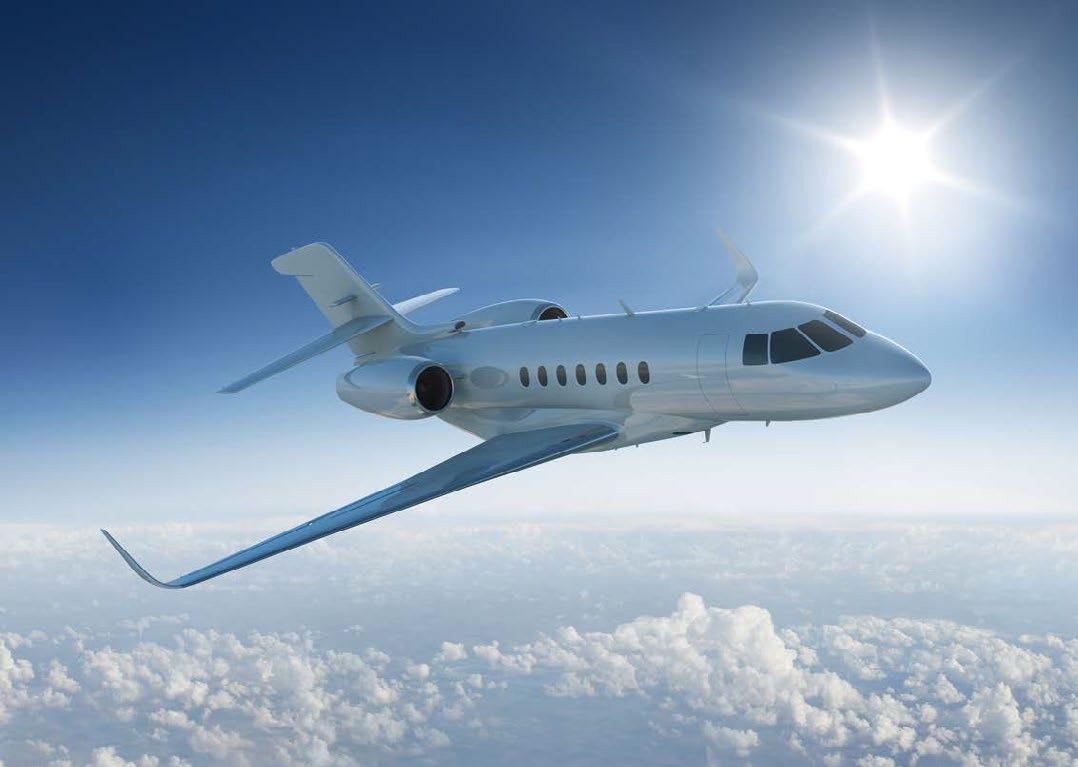
Continued from Page 4
KL: But also, I’m an aviator. So, my job on the mov ie was to apply the camera jet and the camera helicopter. And I had two camera jets. I used an L-39 Cinejet that we trademarked and an L-39 with a shot over on it.
BAJUSA: Understood.
KL: We also used a Phenom business jet that was modified by my good friend, Jonathan Spano. I’m the pilot, so I put together the flight sequences. However, I have an aerial DP or camera operator that sits in these aircraft, (including the helicopter) and they operate the camera. My job is to get them in the right spot so that we can get the best possi ble image. That is what we see on the big screen.
BAJUSA: Did the Phenom keep up with the F-18?
KL: None of the jets that we have keep up with the F-18.
BAJUSA: I can imagine.
KL: Here’s the beauty of what I do. Our job is to sell speed, make things dynamic and energet ic. If you’re in formation with an SR-71 doing mock whatever, it’s just floating in the camera. It’s just sitting there statically if you’re in formation with it. To sell speed, you have to have overtakes. So it’s not a big deal. I use that anal ogy to say it’s not a big deal that we were slower than the assets that we were filming. And a lot of times we want those big over takes just like you’re watching an airshow because it creates this dynamic image, with compres sion and there’s foreground and background movement as the jets are ripping through the camera lens. So that’s something that we actually like. We can pace them and there’s plenty of shots in the movie where we’re in for mation, chasing them through a canyon or dog fighting but typically we want them to go fast.
set, especially with aviation. He’s an aviator to his core. He would show up flying his Honda Jet one day, and hop into his Mustang. He would go do aerobatics, or very interesting sequences for Top Gun: Maverick, where he hopped in the F-18 flying with the Navy. He’s just a very profound individual, and his biggest core drive in life, is to make the best possible product. Everyday he moti vates the cast around him, including myself, to help him make that great product.

BAJUSA: So you’d say he’s a proficient pilot?
KL: Absolutely.
BAJUSA: Ok, cool. Well, I’ll be honest with you. I saw the movie and I walked away feeling like, if I pro duce anything, I’d like to produce something as good as that movie. I was motivated by Tom Cruise. So how about the other actors, Miles Teller and so forth? You made sure they were all trained for this.
KL: One of the jobs early on that I had was putting together a training curriculum with Tom, because it was heavily driven by him. They all needed pilot train ing so that they looked good on camera and understood aviation.
Kevin ‘K2’ LaRosa II sitting in an L-39 jet. (Photo courtesy of Kevin LaRosa II)
So, we put together a training cur riculum, and actually my father and I started training the actors in Cessna 172s. We then graduated them into Extra 300s. That was our friend, Chuck Coleman’s pro gram and then our other friend, Randy Howell, owner of the Patri ot Jet Team, took them into L-39s. By the time they got through that whole training curriculum, they were ready to move into the F-18. It really was about building their G force fatigue and their G force tolerance, making sure that even if they did get sick in those F-18s, they knew how to power through it, and how to handle themselves to keep acting and giving epic performances.
BAJUSA: Well, outstanding! That’s excellent infor mation. Well, let me ask you about young people getting into aviation. What’s your recommendation?
BAJUSA: Ok, great. Very interesting! Of course, everybody’s going to wonder how it was working with Tom Cruise.
KL: It’s not the first time I’ve worked with Tom. I’ve worked with him on a few other projects. I would say Tom is a very motivated professional on the movie
KL: My recommendation is to immerse yourself in aviation as much as possible. If you have the ability, like if you have another job and you’re making money, that’s absolutely fine. Your free time or your side project is try ing to get your license, but really, just give it your all. Hang out at the airport, listen to YouTube podcasts, listen
to ATC recordings, just immerse yourself in aviation so that you understand it. I feel like that better carries you through your flight training process. Also try to knock it out as quickly as you can, and don’t stretch it over time. I think we’re in an interesting place in the aviation industry where pilots are needed more than ever. And I have so many young people and friends that are getting into the industry. I think they’re going to be set for life. It’s an amazing industry, and there are so many different avenues and facets, and different places to go. I can’t advocate enough that aviation is an incredible industry. And if you’re going to do it, just go all in.
BAJUSA: Agreed! I appreciate that advice for the young people. And let me ask you, somebody that’s old er, 50, 60, would you recommend they get in there and go after it if they never did and they wanted to?
KL: Yeah, 100 percent. I mean, I don’t think age has anything to do with it. If you have the mental capacity and time and energy and the finances to put into doing it, you can do it. I don’t really see age as being a limitation.
BAJUSA: Excellent. So what are your future plans now? What do you have coming down the road?
KL: So we have a couple of new movies coming out, another one I did called Devotion. It’s another aerial naval movie that’s going to have lots of practical flying, lots of real stunts. Directed by J.D. Dillard. His dad was a Blue Angel, great guy. Glenn Powell, one of the leads from Top Gun: Maverick, is the lead in this movie. So that’s coming up. That’s a movie that’s taking place in the Korean War era. So we’re looking at Corsairs and Sky Raiders. We have some really big aviation movies this year. This one’s going to be on the backside of Top Gun: Maverick. I think people are excited about real fly ing. They’re going to enjoy Devotion. I’m always trying to set the bar higher, design faster camera jets, or better camera systems that we can then go out and make great images for those folks who go to the movie theater and watch it.
BAJUSA: Excellent. Great answers! I appreciate it so much. I am personally in the business aviation in dustry, and one of the humanitarian efforts that we’re familiar with is Corporate Angel Network. They provide free seats for cancer patients needing treatment on cor porate aircraft. Do you have any humanitarian efforts that you’re thinking about?
KL: I love that. No, we’re looking at a couple of organizations right now and seeing how we can actually get involved.
BAJUSA: Thank you! Do you have anything else
you would like to add personally?
KL: No. I mean, I know most everybody that’s going to read this article has already seen Top Gun: Maverick. If you haven’t, go see it and see it on the biggest possible screen. It’s just an epic movie in so many different ways. And if you love real flying, go see Devotion that comes out this Thanksgiving.
BAJUSA: I hope all our readers get to see both mov ies on the biggest screens possible; I will for Devotion. Your efforts in Top Gun: Maverick have impacted and motivated so many people. Good work and thank you for your time!
KL: Thank you very much.
BAJUSA: We are so grateful to Kevin LaRosa II for his time and wish him continued success in the future!
Eli Stepp has served the Business Aviation Industry for more than 40 years. In addition to founding BizAvJets Inc., and co-founding BizAvJets USA Mag azine, he continues to serve the BizAv Industry on a full time ba sis in multiple roles.


The United States and the world were facing an acute shortage of certified aircraft mechanics holding A&P licenses (Airframe and Powerplant) pre-pandem ic and then it got worse. Because so many A&P me chanics were furloughed or laid off when travel was severely restricted, many have not returned post-pan demic.
For a company that sells, fly’s, manages, main tains, stores, fuels and tears down aircraft for parts, like Threshold Aviation Group at the Chino Airport, this represents quite a challenge. But one they are meeting with creativity.
“I am not a person that waits for other people to solve my problems,” said Mark DiLullo, CEO of Threshold Aviation Group. “So, we have instituted a program to bring more entry-level mechanics directly to our shop by working with local community colleges and trade schools to find the right candidates.”

According to Pete Nichol who oversees the intern ship program for mechanics at Threshold, “We love working with the local colleges that have programs to provide students with A&P licenses, but they have lim ited “hands-on” experience with real aircraft.
Threshold takes in graduates from local colleges and former military personnel with the appropriate skills. They also hire individuals who do not have A&P licenses or military experience if they have mechanical aptitude and a willingness to work and learn the trade.
Previously, newly minted mechanics could find it difficult to get a job because they have no real experi ence with maintaining aircraft, but even major players in the industry have changed their mentality due to the major shortage of qualified applicants.
Nichol went on to say, “In the past, maintenance shops were reluctant to hire freshly licensed A&Ps be
cause of their lack of experience as employers want to hire experienced people. But how do they get the ex perience if no one will hire and train them?” Because Threshold tears down and salvages parts from planes as part of its business, it has a natural place for these new mechanics to get practical experience working on planes that won’t be flying anymore.
Threshold will break down and part out approxi mately 10-12 jets per year with those components stored at Threshold until needed by an aircraft any where in the world and shipped on an as-needed basis.
Serviceable aircraft components from parted-out airplanes are much less expensive than new parts – a small part can cost thousands of dollars whereas a re furbished one will cost significantly less.
Storage of certain sensitive parts such as avionics must be stored in controlled conditions where an ap propriate climate is maintained, and anti-static proce dures are followed. These storage procedures are more than just bagging the parts, throwing them in a box, slapping a shipping label on and dropping the parts off at the local FedEx or UPS office.
Typically, some 1,500 – 2,000 parts are harvested per aircraft and then are inspected, granted proper doc umentation and cataloged in terms of the hours of flight time that the component has left in its life cycle.
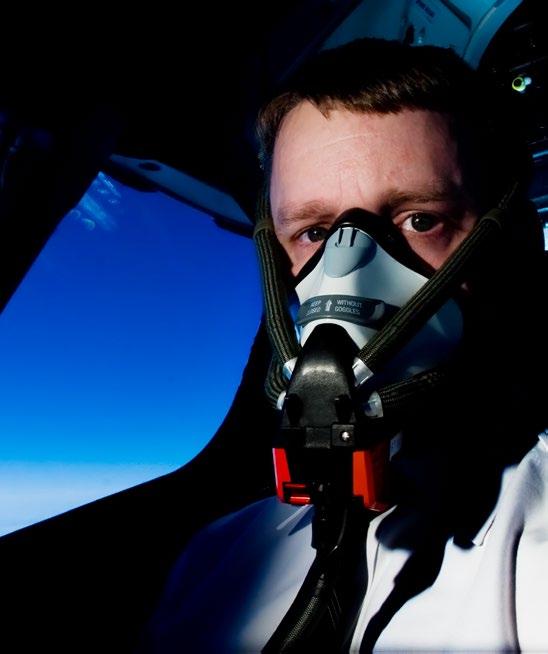
Threshold usually has 20-25 people working in the Repurposing / Part-out Department and about half of them are interns. “The need for people to fill these po
Threshold’s Maintenance Division supports most business jet aircraft (Photo courtesy of Mark DiLullo)
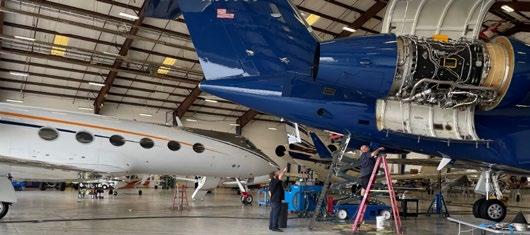
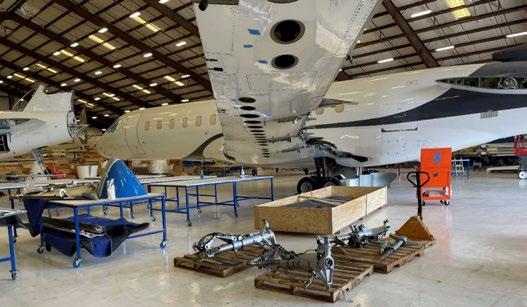
sitions in the industry is not going away and it can be a great career starter for those interested in aviation. We love giving these opportunities to people that are interested in this industry,” said DiLullo.
Mark DiLullo is the founder and Director of Operations of Thresh old Aviation Group. He has 20,000 + flight hours and is rated in 32 jet aircraft, ranging from the Boeing 747 to the Northrop F-5 Freedom Fighter. He can be contacted at mark@flytti.com
Apprentice mechanics gain experience parting out business jets in Threshold’s program. (Photo courtesy of Mark DiLullo)






Tower: “Citation 501 Whiskey Juliet, Chino Tower, Runway 26 Left, cleared for takeoff.”
Me: “Cleared for takeoff 26 Left, Citation 501 Whiskey Juliet.”
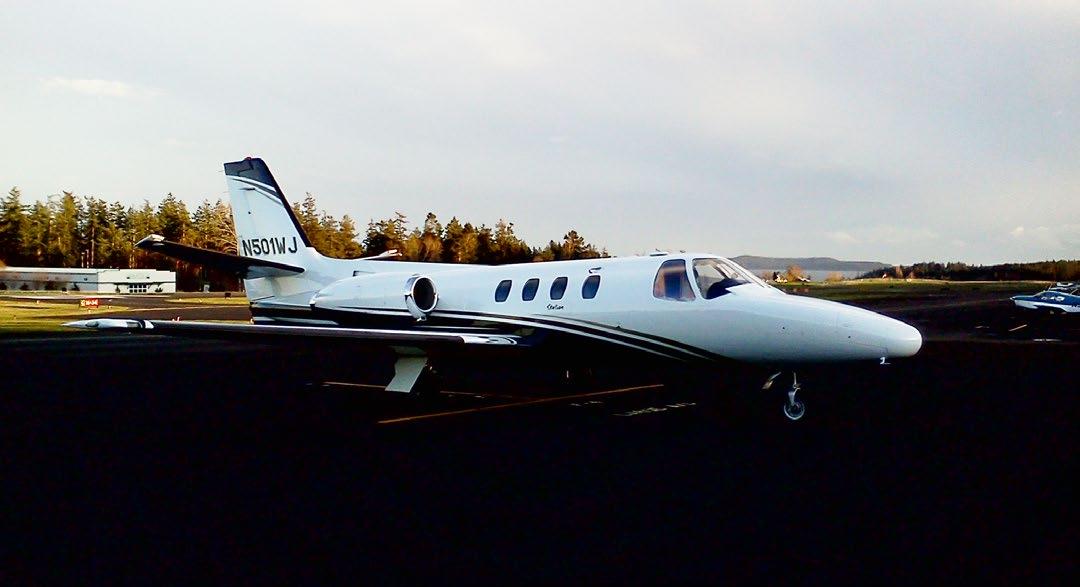
My flight today was a straightforward one. I was giving a demonstration flight to a potential buyer of a Citation Mustang, which is a single pilot Citation 501 modified by Sierra Industries of Uvalde, Texas which replaced the original Pratt & Whitney JT-15 engines with Williams FJ-44s. The extra thousand pounds of thrust transformed what had been a marginal perform ing light jet into a real hot rod.
The potential buyer’s representative was in the right seat. He was a captain on a Challenger of some flavor, and I was to show him what an old steam-gauge Citation could do. Our mission was to deadhead over to Burbank, pick up the potential buyer himself and then continue on to Denver. We would spend half a day
in Denver and then return to Burbank and then finally Chino.
Our weather for this day was not the greatest. A winter Pacific Storm system that was driven by an at mospheric river was producing a band of heavy rain that was moving across the Los Angeles basin. At the time of departure, Chino was VMC under a 3,000-foot overcast, but the rain band began just a few miles west of the field. We were going to have a wet slog over to Burbank, but it wasn’t anything that I hadn’t experi enced before.
I lined up on runway 26 left and added full pow er. The Williams engines were fitted with the Meggit engine control system, which automatically limited my power. It wasn’t a full FADEC because the 501 still had cable control backups, but it came pretty close. V1, ro tate, positive rate, and gear up and flaps up were all uneventful. Passing 1,000 feet, I turned on my autopilot and hit heading mode. Our clearance was to make a
Continued from Page 11
right turn after departure to 300 degrees heading and maintain 4,000 feet.
Tower: “Citation 501 Whiskey Juliet contact SoCal on 135.4.”
Me: “135.4, Citation 501 Whiskey Juliet, good day.”
We entered IMC at around 2,000 feet and immedi ately flew into the band of heavy rain. The noise lev el in the cockpit rose considerably as the heavy rain drops impacted our windshield at cruise climb speed. I contacted SoCal on the assigned frequency as the rain hammered away on my windshield.
Me: “SoCal, Citation 501 Whiskey Juliet, 2 for four thousand, turning to heading three zero zero.”
As SoCal was answering, I was distracted by the audio warning of my autopilot disconnect. Simultane ously, red flags appeared on both my HSI and my atti tude indicator, and then my attitude indicator went to a 90-degree position and stopped working!
I was in a pilots worst nightmare. Total gyro failure in instrument conditions. I looked around for a standby gyro, and to my horror realized that the old Citation didn’t have one! All I had was a turn indicator. I knew that I was in a turn and I was supposed to roll wings level on 300 degrees, which we had nearly been at. At the same time, I knew we were nearing four thousand feet, so I tried to stop my climb. My attempt to level off and roll wings level threw my inner ear completely out of whack! The disorientation that arose from my control inputs, coupled with losing my artificial hori zon and compounded by surprise factor meant that I was quickly losing out to vertigo. I needed help in a bad way.
I said to Tom in the right seat, “Hey Tom, I just lost my gyros. Can you take over the controls and roll us wings level? I have a bad case of vertigo.” While ask ing him this, my over speed horn sounded. I checked my airspeed indicator. It was at least 20 knots over redline, and my altimeter was unwinding fast! Shit! I hadn’t throttled back from climb power! I brought the power to idle to help me slow down. But which direc tion was up, dammit? John answered me, “Matt, I fly a Glass Cockpit. I don’t know how to fly steam gauges any more.” Wow, no help from the right seat.
Meanwhile, SoCal was still trying to call us, “Ci tation 501 Whiskey Juliet, if you can hear me, ident. Traffic Alert…” I lost what else was said by them. I said to Tom, “Declare emergency for me please!” Now my TCAS began blaring, “TRAFFIC! TRAFFIC!” I glanced at my Garmin 530 long enough to see a yellow target somewhere close. Not that that was going to do me any good while completely disoriented in an unusu al attitude.
But drawing my attention to the right helped lead my eyes to the only instrument in that cockpit that could help me; the copilot’s artificial horizon. I focused on it and finally saw my predicament. I was in a steep bank to the right, in excess of 70 degrees and nose down. Ok, now I am finally oriented. Training took over, and I initiated my recovery; Power to idle (it already was), roll wings level, and gently bring the nose back to the horizon. My whiskey compass showed me on a head ing of around 120 degrees. In the space of less than 30 seconds, we had made a 180 degree turn and lost over a thousand feet of altitude. Well at least the wings were still attached to the fuselage!
I focused on hand flying the Citation on my copilots instruments, leveled off at around 2,800 feet, and since John was more or less acting as a passenger, I spoke to SoCal.
Me: “SoCal, Citation 501 Whiskey Juliet, Mayday Mayday Mayday! I have total failure of my attitude gy ros. I am hand flying, relying on my copilots instru ments. Request no-radar vectors back to Chino, and descent to VMC conditions.”
SoCal: “Citation 501 Whiskey Juliet, say heading.”
I checked my whiskey compass.
Me: “Heading approximately 120 degrees, altitude two thousand eight hundred.”
SoCal: “Citation 501 Whiskey Juliet, roger. Fly present heading for now and maintain altitude.”
As SoCal was saying this to us, we began to come back out of the rain band. Once out of the rain, the clouds cleared, and I could make out the valley where Chino Airport was.
We had survived.
As I looked around, my instrument scan picked up my pilots’ side gyros. The artificial horizon and HSI no longer had red flags. The HSI appeared to read around 120 degrees, but the artificial horizon was showing a bank of around 20 degrees. I didn’t care if it was show
ing the center of the Universe to me, I did NOT trust that instrument any more! I continued to hand fly and keep my eyes outside the cockpit for visual references.
Me: “SoCal, Citation 501 Whiskey Juliet. We are now VMC. I have Chino in sight, and request visual approach.”
SoCal: “Citation 501 Whiskey Juliet. Understand you are now VMC. Cleared for visual approach. Before you go, after you have landed, please call us at xxxxxx-xxxx.” I grabbed my pen from a pocket and wrote the number on my knee pad strapped to my leg.
I was handed off to tower, and made an uneventful landing. My passenger Tom left while I called SoCal on the phone. The person on the other end of the line started scolding me. “Do you realize we had to give you traffic emergency instructions to avoid you?” I said to him, “No sir, I was not. I experienced total gyro in strument failure on my side of the instrument panel in IMC, and I am just happy to be alive right now. I am glad he didn’t hit me, but I was in an unusual attitude and I was too busy trying to get back to wings level to do much else at the time.”
I filed a NASA ASRS report – the first one I had ever filed in my career. I never heard back from FAA either. Between my mayday call and my explanation of gyro failure, I guess SoCal figured they had enough information.
So what had gone wrong?
This particular Citation 501 had electrically-driv en mechanical gyros located in the nose radome. These gyros communicated electronically to a pair of gyro re peaters in the cockpit on the pilot’s side–the Artificial Horizon and HSI. Unknown to me at the time, there was a small hole in the radome. When I flew into the heavy rain, water entered into the radome through this hole and began spraying onto a connector on the gyros. The water shorted out the signal from the gyros to the gyro repeaters. When this happened, the lack of signal from the gyros caused the flight director and autopi lot to disconnect, my artificial horizon went vertical, and red flags appeared in both the artificial horizon and HSI. This happened while I was about to end a climb ing right turn and level off – a worst case scenario. The sudden loss of attitude instruments while attempting to
return to wings level AND level off proved to be too much for my inner ear to process, and my attempts to do both pushed me into a classic Death Spiral. I knew I was in an unusual attitude when my overspeed horn sounded, but it was my TCAS alert that drew my focus over to the copilot’s artificial horizon and allowed me to recover.
Once I exited the heavy rain, the water ceased to pour onto the connector, the shorted out connector quickly dried out, and the gyro repeaters began func tioning again. Due to the unusual attitude I ended up in while I was orienting myself, the resulting gyroscopic precession made the artificial horizon show a 20 degree bank while I was in level flight so I did not trust it at all.
After I had completed my phone call to SoCal, I called the owner/seller to explain to him what had happened. I told him he had probably lost this sale, I did not care, and I would not take any more contract flights for him on this airplane until he had this particular problem fixed.
That took a long time to happen.
In fact, the owner continued to fly this airplane himself – believing that there was not a problem and for some reason I was just a pissed off pilot. I found out six months later that the owner finally had the problem happen to him personally – in heavy rain and IMC–and he too barely escaped the unusual attitude alive. It was only then that he had maintenance take a close look into the nose cone and discovered the problem.
After this problem had been fixed, I continued to do contract flights for the owner while he tried to sell it. Despite nearly killing myself in this airplane I was happy to fly it once I knew I wouldn’t have a recurrence of the problem. Thanks to this, I was flying this same airplane three years later when I had my encounter with The Blackbird.
Note: Please go to BizAvJets USA’s Summer 2022 edition to read Matt’s story, The Blackbird.
Matthew Odenbrett is a 12,000 hour ATP and CFII with Gulfstream IV and Citation type ratings. During his 22-year career, Matthew has served as Chief Pilot, Check Airman, and Flight Department Manager for var ious companies. Matthew currently serves as Captain on a Gulfstream IV for a charter company, and is a Contract Captain on both the GIV and Pilatus PC-12.

Phone call one particular afternoon:
“This is Rob.”
“Hey Rob, Matt on this end.”
“Hey Matt, how was your charter flight today?”
“It was fine, but my passenger made a remark to me that indicates we have a very serious problem on our hands.”
“Oh, what’s that, Matt?”At the time of this story, I had been flying the Pilatus PC-12 for seven years. I had served as Chief Pilot for a short-lived commuter air line in Nebraska and New Mexico, then I moved on and operated a one-man flight department for a corporation in Southern California. When the banking collapse of 2008 happened, I was scrambling to remain gainfully employed. Eventually, I began managing a PC-12 for a private owner, and when he decided to lease his airplane to a charter company, I went with it. The prospect of having a steady income appealed to me, and I thorough ly enjoyed flying the Pilatus.
Hardy Air Charters was a fairly new operation, and
when I joined them, they had a fleet of 5 PC-12’s, which made them the largest operator of the type on the West Coast. The flying was fun, and I enjoyed the camara derie of my fellow pilots. But as with all new startups, they had their share of challenges. They had a great sales team, and the owner was a real go-getter, but sometimes payroll would be lagging. This was a red flag, but even a paycheck that was sometimes late was preferable to the unemployment line.
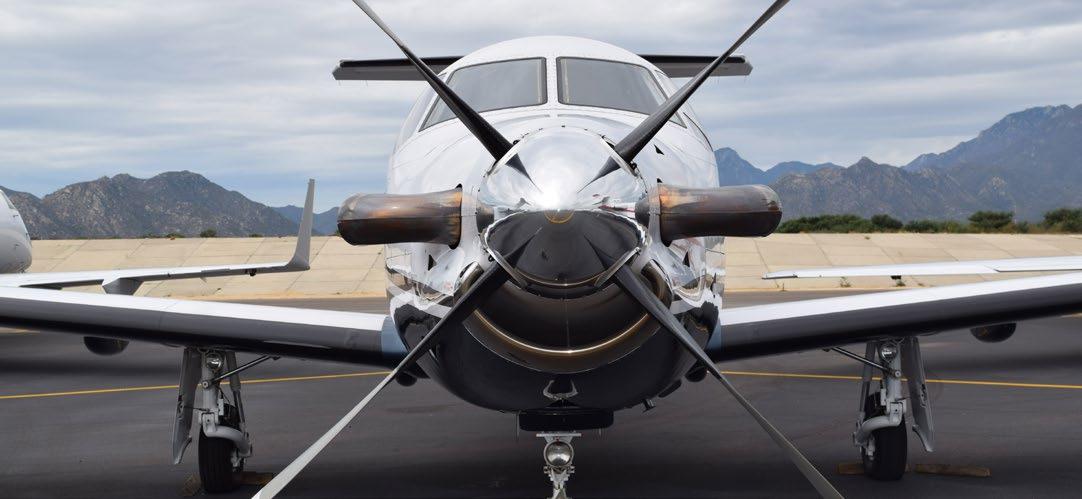
Eventually there was a change in the management structure of the company. Rob was a retired American Airlines captain who was hired to be Director of Oper ations, and to help grow the company. I was eventually offered the position of Chief Pilot, a position which I had held before. I was already an Instructor Pilot, so I was also tasked with initial and recurrent training. I took on both of my positions with gusto, and Rob and I became fast friends.
The problems that came along were serious. 2011 was still a period of economic unrest, and the owner Har dy was facing many challenges keeping airplane owners,
Continued from Page 14
clients, and pilots satisfied. While Hardy Air had five PC-12’s when I began, two left soon after. A few months later, the PC-12 that I came to the company with was sold by the owner, and another was repossessed from the company. Being the company representative who had an airplane taken away from me by an irate person flashing court papers in my nose was the most unpleasant expe rience.
So, in the fall of 2011, Hardy Air had a great sales team, a fine management team, and enough clients to keep three PC-12 airplanes busy. The only problem was that we were down to just one airplane. In such circum stances most 135 operators would call their competitors and ask them to do the charters that could not be han dled internally, but the company’s namesake – Hardywas the kind of go-getter who was so driven to keep his company afloat that he would cut whatever corners he thought he could get away with so he could pocket all the profits. This eventually led Hardy to a confrontation with Rob and me.

Hardy was not only the owner of Hardy Air, he was also one of the line pilots and a good one at that. He befriended numerous airplane owners besides the PC-12 owners who had leased their airplanes to him. I knew from conversations with Hardy that he helped out a cou ple of airplane owners by providing pilot services to them on their airplanes. One owned a Cessna 414 and
another owned a Piper Meridian.
One particular November morning, I had an early morning departure for a charter. I arrived at the FBO extra early and went out to the company’s sole remain ing Pilatus to conduct my preflight and get it ready for the day. As I was conducting my preflight inspection in the pre-dawn gloom, I noticed one of our regular cus tomers – a young boy named Charlie – walking across the ramp unescorted. I knew Charlie because his par ents were divorced, and we transported him back and forth between his father’s home in SoCal and his moth er’s home in Central California every other week or so. “That’s strange,” I thought, “we don’t have a charter for Charlie on our schedule today.” I was about to walk over and say hello to Charlie, when I realized that Charlie was walking towards the Cessna 414 owned by Hardy’s friend! It was too dark for me to make out any details, and when Charlie got to the 414 he climbed in and some one inside closed the cabin door.
I kept thinking to myself, “This can’t be happening, can it?” I continued my preflight but kept an eye on the 414 as the pilot inside started his engines and began his taxi off the ramp and out for takeoff. I could not identify the pilot – it was too dark – but it was easy to take two and two and come up with four. I had to know for sure, so I walked back into the FBO and spoke to the customer service representative at the fuel desk.
“Hi Matt, how are you this morning?”
“Hi Rachel, can you help me with a couple questions?”
“Sure.”
Continued on Page 16
from Page
“That young boy who just walked out to the 414, was that Charlie?”
“Yes, it was.”
“And who was the pilot of the 414?
I couldn’t see him.”
“Well it was your boss, Hardy.”
“Do you know where he was going?”
“I don’t know, he didn’t say.”
“Ok, thank you Rachel. I’ll be back in a little bit to wait for my passenger.”
My employer had just taken one of our regular char ter passengers out and took off on a flight in an airplane that was NOT ON OUR CERTIFICATE! I was in shock. Not only could this kind of activity lead to FAA revo cation of Hardy Air’s operating certificate, it could also

lead to certificate action against myself! As Chief Pilot, I was tasked with operational control, which in the eyes of the FAA is a special trust. Operational control meant that any and all charter flights had to be reviewed by either me or the Director of Operations, Rob, and we had to approve all flights. On the surface, it appeared that the owner of my company was conducting charter flights without my knowledge or the knowledge of the DO, using airplanes that were not on our certificate. This was placing my entire career in jeopardy.
But could I be mistaking? Maybe there was an ex planation. I didn’t know the destination of the 414, but I could easily find out. I went to the FBO’s flight planning room and logged into my FlightAware account. I entered the registration of the 414 and received an immediate response. Hardy was going to the usual airport that we would take Charlie to. Not good. I double checked, then triple checked. This is NOT the way I wanted my day to begin!
I still had a charter to do, however. My passengers arrived and we took off and climbed into a beautiful fall
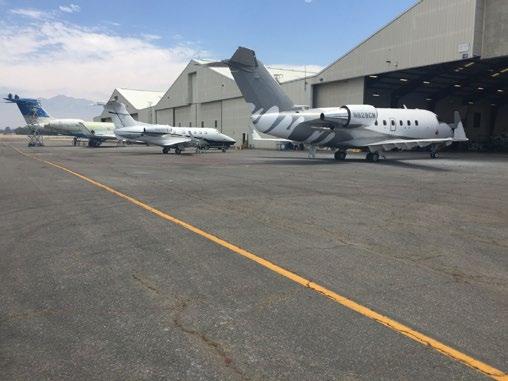
Continued from Page 16
morning sky. Our trip to Concord, Calif. was uneventful, and we landed after just an hour and 45 minutes of flight time.
As I unloaded the last of my passengers’ bags, the lead passenger thanked me for a very nice flight, and then added a few additional words that made my heart sink.
“Thanks, Matt. Boy, this airplane is so much roomier than the last airplane Hardy flew me in.”
Uh oh! Not another Charter client being flown in an unapproved airplane! I played the innocent, and replied. “Oh? What airplane was that?”
“I don’t remember the name of the airplane.”
“Did it have one engine or two?”
“It had one engine–a turboprop - and I think it began with a P.”






“Was it a Piper Meridian?”
“Yeah! That’s the name of it! It was a heck of a lot smaller than this airplane. I want to fly in this airplane from now on.”
“Well, sir, I will speak to Hardy about it.” He drove off in his rental car, and I went back to my airplane. I
was supposed to fly back to SoCal because there were more charters to do over the weekend. Charters maybe, but I was determined to get to the bottom of what was happening at my company.
I was livid. In the space of one morning, I had not one but two instances of charter customers being flown by Hardy in two different airplanes that were not on our certificate. Now that I had knowledge of this, I had to put an end to it. I knew that if I did nothing and turned a blind eye to the situation, then the FAA would revoke my certificate when they found out about it. They would probably revoke the certificate of my DO if he was privy to what was going on as well.
So as I began my drive home, I picked up my cell phone and rang my Director of Operations and friend, Rob. It was time for us to take action.
Matthew Odenbrett is a 12,000 hour ATP and CFII with Gulfstream IV and Citation type ratings. During his 22-year career, Matthew has served as Chief Pilot, Check Airman, and Flight Department Manager for var ious companies. Matthew currently serves as Captain on a Gulfstream IV for a charter company, and is a Contract Captain on both the GIV and Pilatus PC-12.

It’s as simple as that. When you choose West Star Aviation, you choose the peace of mind that comes with choosing the only MRO voted #1 for eight consecutive years (Pro Pilot PRASE Survey). You choose a company with experience on your specific airframe. You choose a full-service MRO with a full range of capability, four full-service locations and a network of satellite locations.
But, most importantly, you choose an MRO partner that is focused on YOU, the customer. Come see for yourself how our experience shines.
As many of you know, I spent years at the National Transportation Safety Board as a board member respon sible for determining the probable cause of accidents in aviation and other modes of transportation. Since leaving the Board, I have continued to be involved in reviewing accidents that occur around the country and even around the world as a consultant for entities in volved in accident litigation. I also keep up-to-date on accident trends, subscribing to a number of news aggregators, as well as aviation trade publica tions.
Looking at accident data on a regular basis, some trends jump out. While not a scientific analy sis, there seem to be a number of accidents and incidents since the beginning of the year involving student pilots flying helicopters, either soloing or with an instruc tor. Helicopter training acci dents are not unusual but with sales of new helicopters up more than 25 percent since last year, a bump in the accident rate involv ing students would not be unex pected. Anecdotally, however, the increase seems to me to be greater than what even a large increase in sales would foretell. It may be appropriate for the NTSB or the FAA to take a focused look at whether there is, in fact, a significant increase in helicopter incidents and accidents and whether there are any common underly ing causes.
was in for a heavy maintenance visit and the floor and side walls of the baggage compartment were removed in order to gain access for some maintenance work that was re quired on the motorized loading system which was tagged inoperative because of several previous issues. When the floor was removed the insulating blanket under both the sidewall and floor was found to have burned over an ap proximately 8 by 10 foot area. Fortunately, these blankets were of the type that did not sup port burning if the heat source was removed (circuit breaker popped for the powered container loader system electric motor) avoiding a major problem. The area of maxi mum damage clearly indicated the ignition source and the manufac turer generated a bulletin to check other aircraft with this system in stalled.
Accident Helicopter. (Photo courtesy of CFI Branda)


Dust and debris have been known to cause combustion which can be very difficult to lo cate. I say this because it is be holding on all of us to clean our work areas and to clean where others have been less thoughtful. All jobs in aviation are important and need to be accomplished by the rules and processes. There is no room for shortcutting the process as we have many ex amples of people doing just that and the painful out comes. We need to pay proper attention and perform our duties to the best of our ability.
Another trend I’ve noticed is the number of events on commercial airplanes involving smoke in the cock pit (including the entire aircraft). My informal survey indicates regular such events occurring on a weekly ba sis involving various manufacturers somewhere in the world. And yet there doesn’t seem to be much-concert ed attention focused on why these events are happening and what can be done about them.
Of course, smoke can be an indicator of a significant problem and yet be difficult to trace once the smoke has cleared. Years ago I received some photos of a DC10 that
Mr. John Goglia has worked in both the private and public sec tors, from leading the Depart ment of Transportation to run ning his own aviation business. With more than 40 years in the aviation industry, he is the only A&P mechanic ever named to the National Transporta tion Safety Board, where he served from 1995 to 2004. He has proven to be a true leader, adhering to the high est professional standards in the industry and is presi dent of John Goglia, LLC.
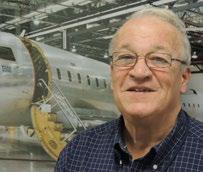
Swedish electric airplane maker Heart Aerospace on Sept. 15 unveiled significant design updates to its first electric aircraft and confirmed Air Canada, one of North America’s largest airlines and Saab, the Swedish aero space and defense company, as new minority sharehold ers.
The new airplane design, called the ES-30, is a re gional electric airplane with a capacity of 30 passengers and it replaces the company’s earlier 19-seat design, the ES-19. It is driven by electric motors powered by batter ies, which allows the airplane to operate with zero emis sions and low noise.
Air Canada and Saab have each invested USD 5 mil lion in Heart Aerospace. In addition to its investment, Air Canada has also placed a purchase order for 30 ES30 aircraft.

“We are thrilled to have two such strong partners as Saab and Air Canada join our mission to electrify re gional air travel. Growing up in Sweden, Saab is syn onymous with aerospace, and our partnership will not only support our program, but help us to become a part of the proud Swedish aerospace heritage,” said Anders Forslund, founder and CEO of Heart Aerospace. “Air Canada is a strategically important partner with one of the world’s largest networks operated by regional turbo props, and as a progressive, future leaning company.”
“Air Canada is very pleased to partner with Heart Aerospace on the development of this revolutionary air craft. We have been working hard with much success to reduce our footprint, but we know that meeting our net-zero emissions goals will require new technology such as the ES-30. We have every confidence that the team at Heart Aerospace has the expertise to deliver on the ES-30’s promise of a cleaner and greener aviation future,” said Michael Rousseau, President and Chief Ex ecutive of Air Canada.
The ES-30 has a comfortable three-abreast flat-floor cabin seating and it features a galley and a lavatory. Cab in stowage and overhead bins will add to the large exter nal baggage and cargo compartment and provide airlines with network flexibility.
The airplane will also include a reserve-hybrid con figuration, consisting of two turbo generators powered
Swedish electric airplane maker Heart Aerospace recently unveiled significant design updates to its first electric aircraft. (Photo courtesy Heart Aerospace)
Air Canada has partnered with Heart Aerospace on the development of the ES-30, expecting that meeting their net-zero emissions goals will require new technology offered of Heart’s new aircraft. (Photo courtesy Heart Aerospace)
Heart Aerospace’s ES-30 is a cost efficient airplane that, on top of significant fuel savings, is cheaper to operate than a larger turboprop due to its electric propulsion. (Photo courtesy Heart Aerospace)


sustainable aviation fuel. The reserve-hybrid system is installed to secure reserve energy requirements with out cannibalizing battery range, and it can also be used during cruise on longer flights to complement the elec trical power provided by the batteries.
This gives the airplane a fully electric range of 200 kilometers, an extended range of 400 kilometers with 30 passengers, and flexibility to fly up to 800 kilome ters with 25 passengers, all-inclusive of typical airline reserves.

“The ES-30 is an electric airplane that the indus try can actually use. We have designed a cost efficient airplane that allows airlines to deliver good service on a wide range of routes,” said Forslund. “With the ES30 we can start cutting emissions from air travel well before the end of this decade and the response from the market has been fantastic.”
“This underlines our commitment to innovative technology and solutions for sustainable aviation. Heart is a pioneer within commercial electric aviation and we look forward to contributing to the future of avia tion with our experience of developing solutions at the forefront of technology,” said Micael Johansson, Saab’s

President and CEO.
Previous orders for Heart Aerospace’s ES-19 electric airplane, placed by United Airlines and Mesa Air Group for a total of 200 electric aircraft with an option for an additional 100 planes, are reconfirmed for the updated ES-30 design.
“From the beginning Heart and United have been on the same page – with an acute focus on safety, re liability, and sustainability. Heart’s exciting new design – which includes expanded passenger capacity from 19 to 30 seats, and a state-of-the-art reserve-hybrid engine –is the type of revolutionary thinking that will bring true innovation to aviation,” said Scott Kirby, CEO of United Airlines.
In addition to those commitments, many of the ES19 letters of intent (LOI) holders have already updated their respective letters to reflect the ES-30. These include the Nordic airlines Braathens Regional Airlines (BRA), Icelandair and SAS as well as New Zealand’s Sounds Air. Rockton, a Swedish-based lessor who has made it their mission to focus on sustainable solutions for the in dustry, has just signed an LOI with for up to 40 airplanes.
In total, Heart Aerospace has LOIs for 96 ES-30s.
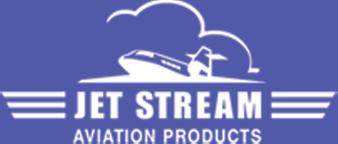
The ES-30 is a cost efficient airplane that, on top of significant fuel savings, is cheaper to operate than a larg er turboprop due to its electric propulsion. The airplane

Continued from Page 21
has also been designed to accommodate battery technology evolution, which will increase its fully electric range and make it even more cost efficient over time.
The ES-30 is expected to enter into service in 2028. Heart’s mission is to create the world’s greenest, most affordable, and most accessible form of transport. This mission is grounded in the outlook that electric air travel will become the new normal for regional flights and can be transformational in addressing the industry’s key sustainability challenges. Learn more at the company’s website, www.heartaerospace.com.

Modern Aviation announced on Sept. 22 that it has closed the acquisition of the FBO assets and operations at Des Moines International Airport from Elliott Avia tion, bringing its total number of locations to 13.
Modern’s new FBO in Des Moines operates on a 17-acre leasehold and offers state-of-the-art facilities and amenities such as conference rooms and worksta tions, sleep rooms, crew cars and comfortable lounge areas with approximately 145,000-square-feet of heated hangar space and 20,000-square-feet of office space.
Elliott will continue to operate a maintenance, re pair, and overhaul business on the airfield.
Mark Carmen, Modern Aviation’s CEO, stated, “We are very excited about our new operation in Des Moines, which provides our customers access to our services for the first time in the Midwest. Elliott Aviation has a long history of providing outstanding customer service to its customers through its highly experienced and long-ten ured employees, all of whom have joined Modern. I would like to extend a warm welcome to the Modern Aviation family, to our new teammates and customers. We also look forward to partnering with the Des Moines Airport Authority to continue to grow DSM and benefit the local community.”
Greg Sahr, President and CEO of Elliott Aviation, said, “Divesting our Des Moines FBO business to a great partner in Modern Aviation is a win-win for Elliott Aviation, our employees, Modern Aviation, and the Des Moines community. While our FBO employees will con tinue to provide exceptional service at the DSM location under the Modern umbrella, this divestiture will allow Elliott to focus our efforts and investment on growing our MRO business across our geographic footprint.”
Modern Aviation announced on Sept. 22 that it has acquired the FBO assets and operations from Elliott Aviation at Des Moines International Airport. (Photo image courtesy of Modern Aviation)

Continued from Page 22
In addition to Des Moines, Iowa (DSM), Modern Aviation operates at Wilmington, North Carolina (ILM), Seattle, Washington (BFI), Denver, Colorado (APA), San Juan, Puerto Rico (SIG), LaGuardia Airport, NY (LGA), John F. Kennedy Airport, NY (JFK), Long Is land MacArthur Airport, NY (ISP), Republic Airport, NY (FRG), Francis S. Gabreski Airport, NY (FOK), Sacramento Executive Airport (SAC), Sacramento In ternational Airport (SMF) and Sacramento Mather Air port (MHR).
Modern Aviation is a growing company that is building a national network of premium FBO proper ties. Modern Aviation’s strategy is to acquire and devel op FBO operations in growth markets and to focus on providing exceptional service, extraordinary quality and industry-leading safety. Modern Aviation is backed by the growth-oriented infrastructure private equity fund,
Tiger Infrastructure Partners. Modern Aviation is ac tively engaged in pursuing additional FBO acquisitions and development opportunities in North America and the Caribbean. For more information visit: https://mod ern-aviation.com.
Elliott Aviation has been developing and deliver ing aviation solutions to their partners for more than 80 years. As one of the longest-standing companies in aviation, Elliott Aviation offers a complete menu of high-quality products and services, including aircraft sales (as Elliott Jets), avionics service and installations, aircraft maintenance, accessory repair and overhaul, paint and interior. Serving the business aviation industry nationally and internationally, Elliott Aviation has facil ities in Moline, IL, Des Moines, IA, Minneapolis, MN, Atlanta, GA and Dallas, TX. The company is a member of the Pinnacle Air Network, National Business Aviation Association (NBAA), National Air Transportation As sociation (NATA), and the International Aircraft Dealers Association (IADA). For more information, visit www. elliottaviation.com. Elliott Aviation is majority-owned by Summit Park.
Elliott is located on the north side of the Des Moines International Airport next to the Control Tower on McKinley Avenue. (Photo courtesy of Elliott Aviation)
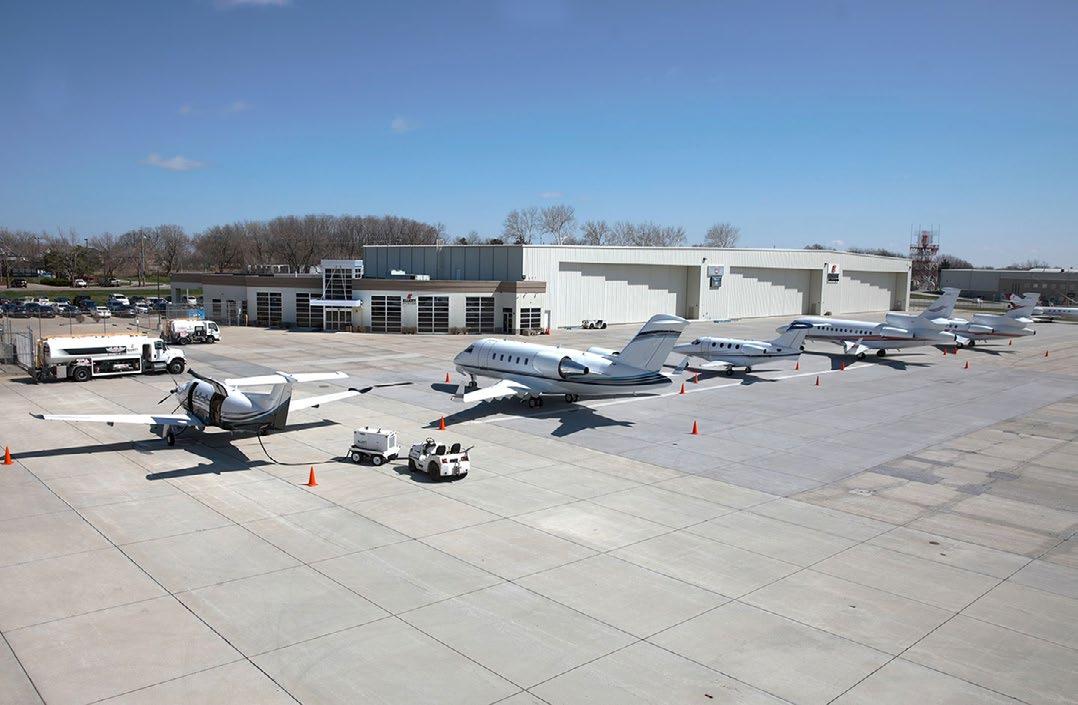
An artist’s rendering of Eviation Aircraft’s Alice, all-electric aircraft, that successfully completed its first flight on Sept. 27. Alice produces no carbon emissions, significantly reduces noise, and costs a fraction to operate per flight hour compared to light jets or high-end turboprops. (Image courtesy of Eviation)
Successful First Flight of Zero-Emission Alice Ushers In New Era of Electric Aviation

Eviation Aircraft, a manufacturer of all-electric air craft, successfully completed the first flight of its ze ro-emission Alice aircraft, a historic day and major mile stone in electric aviation. Alice lifted off at 7:10 a.m. on Sept. 27 from Grant County International Airport (MWH), flying for eight minutes at an altitude of 3,500 feet. This trailblaz ing flight of the technology demonstrator provided Eviation with invaluable data to further optimize the aircraft for commercial production.
“Today we embark on the next era of aviation – we have successfully electrified the skies with the unforget table first flight of Alice,” said Eviation President and CEO Gregory Davis. “People now know what afford able, clean and sustainable aviation looks and sounds like for the first time in a fixed-wing, all-electric aircraft. This ground-breaking milestone will lead innovation in sustainable air travel, and shape both passenger and car go travel in the future.”
Alice produces no carbon emissions, significantly reduces noise, and costs a fraction to operate per flight hour compared to light jets or high-end turboprops.
All-electric aircraft will make regional travel more economically and environmentally sustainable for busi nesses and consumers. This new generation of aircraft has the power to transform communities by providing access to airports not currently used by commercial flights due to noise concerns or restricted operating hours. Eviation Alice is targeted at commuter and cargo markets, and will typically operate flights ranging from 150 miles to 250 miles.
Cape Air and Global Crossing Airlines, both U.S.based regional airlines, have placed orders for 75 and 50 Alice aircraft respectively. DHL Express is Eviation’s first cargo customer, with an order of 12 Alice eCargo planes. With this engagement DHL aims to establish the first electric express network, leading the way for a new era of zero-emissions air freight.
“The first flight of Alice represents a transformation al milestone for the aviation industry,” said Cape Air
Continued from Page 25
Founder and Board Chairman Dan Wolf. “We currently fly more than 400 regional flights per day, connecting more than 30 cities across the United States and Ca ribbean. Alice can easily cover 80 percent of our flight operations, bringing sustainable, emission-free travel to the communities we serve.”
“The first flight of Alice confirms our belief that the era of sustainable aviation is here,” said Geoff Kehr, Se nior Vice President, Global Air Fleet Management, DHL Express. “With our order of 12 Alice e-cargo planes, we are investing towards our overall goal of zero-emissions logistics. DHL is the industry leader by introducing new and more sustainable cargo aircraft types to the global market. Alice is the true game-changer by enabling long distance air transport for the first time with zero emis sions. This historic flight marks a significant milestone on our journey to ultimately achieving net-zero emis sions by 2050.”
Flying electric aircraft will provide a sustainable, emission-free way to travel.
The all-electric Alice aircraft features:
• Max operating speed: 260 knots
• Max useful load: 2,500 lbs for passenger version
Alice is available in three variants including a nine-passenger commuter, an elegant and sophisticated six-passenger executive cabin, and an eCargo version. All configurations support two crewmembers. The ex ecutive cabin and eCargo variations are identical to the commuter configuration, except for the interior.
Alice is powered by two magni650 electric propul sion units from magniX, the only flight-proven electric propulsion systems at this scale. Other key suppliers include AVL (battery support), GKN (wings), Honey well (advanced fly-by-wire system, flight controls and avionics), Multiplast (fuselage), Parker Aerospace (six technology systems), and Potez (doors).
Alice’s advanced battery system is highly efficient and endlessly upgradeable enabling range improve ments as battery technology evolves. The aircraft also incorporates a fly-by-wire cockpit, providing greater re liability and systems redundancy.
Based in Washington State, U.S., Eviation Aircraft Inc. develops and manufactures efficient electric air craft to deliver a competitive and sustainable solution for the regional mobility of people and goods. Its elec tric propulsion units, high-energy-density batteries, mission-driven energy management, and innovative airframe are designed from the ground up for electric flight. To learn more visit www.eviation.com.
Business Aviation Group (“BA Group”) brings a multi-disciplinary team to a new project at Yampa Val ley Regional Airport (KHDN) in Hayden, CO, serving Northwest Colorado, including Craig, Hayden, and Steamboat Springs, after being awarded a general avia tion hangar development contract.
“This project will address the current lack of han gar space. We can’t meet the demand for hangar space right now, and that demand is expected to increase in the coming years,” said Kevin Booth, C.M., Yampa Valley
Regional’s Airport Director.
Booth explained the airport’s selection team felt BA Group understood the intent of the RFP, which was to maximize the amount of hangar space available.
“People tend to think of hangar space as just a place to park an aircraft, but we have an eye towards attract ing aviation-related businesses,” said Booth, adding BA Group’s proposed project and team can help attract that type of business to the airport.
Continued from Page 26
Yampa Valley Regional Airport exemplifies the size and type of airport BA Group specializes in – small re gional airports with a strong focus on general and busi ness aviation and some scheduled commercial air ser vice.
“The project at Yampa Valley compliments ongoing and past BA Group projects in Loveland and Rifle, Col orado, creating synergy on the Front Range from an air port development standpoint,” said Barry Sherman, BA Group Partner/Principal and architect.
BA Group will manage the development of nine new hangars, including two 120x120 large hangars, three 80x60 medium hangars, and four 60x60 small han gars. These hangars will accommodate medium-sized
business aircraft up to large business jets. Medium and large hangars will feature office spaces and restrooms. All hangars will consider sustainability initiatives, with LED lighting, energy-efficient insulation, and capabili ties to add solar power.

The development parcel is on the east side of the air port, near the Atlantic Aviation FBO.
Awarded the project in June, BA Group plans to break ground in November.
“This project is on an aggressive but realistic time line. We are scheduled to begin in November of this year and complete the project in the fall of 2023,” said Sher man. “BA Group’s multidisciplinary team of experts will oversee architecture, design, and construction while also managing marketing and real estate initiatives.”
BA Group has already engaged Tally Ho Construc tion, Interport Capital, and Hauser Architects as project partners.
Learn more about BA Group at www.bagroup.aero.
BA Group will manage the development of nine new hangars at Yampa Valley Regional Airport in Hayden, Colorado. (Image courtesy of BA Group)

Pilatus announced last month that it has acquired its partner of many years, Skytech, Inc., which will continue to operate as an independent company. (Photo courtesy of Pilatus)

Founded in 1976, Skytech Inc. is a specialist service provider and aircraft vendor with two locations in the U.S. states of Maryland and South Carolina. As part of an upcoming succession plan, Pilatus has decided to take over Skytech, and the entire workforce of 120 or so will continue to be employed by the Swiss aircraft manufacturer.
Skytech has operated as a Pilatus independent Authorized sales & service center since 1993. With a successor due to replace co-founder and owner John Foster, Pilatus has decided to acquire its partner of many years. The busi ness will continue to operate as an independent company with responsibility for servicing and sales of PC-24s and PC-12s on the East Coast, as well as aircraft types from other manufacturers. The Skytech brand will also remain. The current Skytech CEO, Justin Lazzeri, will lead the company into the future with his team, which includes many long-serving employees. Both business locations in Rock Hill (South Carolina) and Baltimore (Maryland) are in cluded in the purchase.
This acquisition, announced on Sept. 23 will allow Pilatus to expand its direct involvement in the U.S. market, a market of great importance to the company. Pilatus already has a Colorado-based subsidiary, Pilatus Business Air craft Ltd, which has been in operation for the past 26 years. Acting as the Pilatus general importer and completion centre for North and South America, the subsidiary is also responsible for managing Pilatus’ authorized sales and service center network, marketing and final assembly work. Direct Sales to fleet and government customers are also handled through the Colorado operation. Assisted by its other sales and service partners, Pilatus will use the acqui sition of Skytech to ensure and further improve the continuity and quality of its award-winning customer service on the East Coast of the U.S.
Markus Bucher, CEO of Pilatus, commented on the occasion of the signing of the contract:
“The U.S. market is very important for us. It is essential that Pilatus continues to expand its ‘footprint.’ Through this acquisition, we aim to live up to our claim: ‘We create the Pilatus Class!’ I’m delighted to have the company and its staff on board with us – Welcome to the Pilatus Family!”
The parties have agreed not to disclose the purchase price. Further information about Skytech is available at skytechinc.com.


Anti-magnetic. 5-day power reserve. 10-year warranty.

The new ProPilot X is powered by Oris Calibre 400.
